Routes a communication to a user or treatment (such as a queue or hunt group) configured in storm PBX/CONTACT.
|
Routes a communication to a user or treatment (such as a queue or hunt group) configured in storm PBX/CONTACT. |
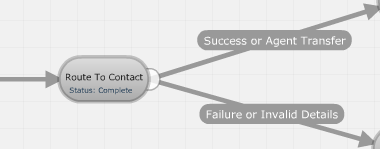
Contact treatment type
Select the treatment type.
Contact Treatment
Select the individual user or treatment:

For 'Voicemail Retrieval', you can enter the name/username of the user (prefixed by =) to whose voicemail box the call should be routed. If you do not, the caller will be prompted for a mailbox extension on the call.
For 'Callback Queue', you must enter the callback number for the queued caller.
For all treatment types except 'Voicemail', select '[Dynamic Content Treatment]' to use a variable value rather than a fixed entity. This may contain a value obtained from a database lookup, for example.
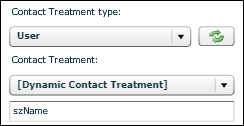
Input Variables
Use this section to build a list of variables to pass to DTA agents or to a CRM application. In the Name field, enter a label for the value to display to the agent or the parameter name to be used by a CRM application. In the Value field, provide the variable. Click Add to add the name/value pair to the list below.
You can reorder the variables by clicking and dragging an item to the location indicated by the black line.
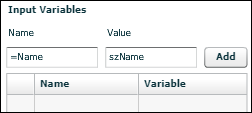
These input variable fields can be used to identify information to be displayed in an agent script. (Agent scripts allow agents on voice calls to read on-screen text in the DTA. See the PBX and CONTACT Configuration Guide for more information.) The name assigned to a field here must match the name given to the variable used in the agent script.

To identify a variable that is not to be used in an agent script, prepend the name given to it with an underscore character.

For a text-based or OUTBOUND preview communication, you can substitute the message data that is passed to DTA agents with alternative values. This is useful if, for example, you wish to present alternative information such as an amended origination or message.
|
For this type of message |
To use this element |
Enter this in the Name field |
|
SMS record |
SMS Origination |
_SMS_ORIGINATION |
|
SMS Destination |
_SMS_DESTINATION |
|
|
SMS Message |
_SMS_MESSAGE |
|
|
SMS Keyword |
_SMS_KEYWORD |
|
|
Email record |
From Address |
_FROM_ADDRESS |
|
To Address |
_TO_ADDRESS |
|
|
CC Address |
_CC_ADDRESS |
|
|
Email Subject |
_EMAIL_SUBJECT |
|
|
Email Message Body |
_EMAIL_MESSAGE |
|
|
For OUTBOUND campaigns that use preview pacing profiles |
Destination number |
_PREVIEW_DESTINATION |
Use the value to substitute in the Value field. For example:

Select the Store Input Variables against Recording to store the input values against the call recording for visibility in storm RECORDER fields. These fields must be configured by Content Guru. Contact your local support representative for more information.
Use this to specify the URL for a web page that will appear in a separate browser window or tab for DTA agents handling the communication.
Note: the URL must have been set up for your organisation by Content Guru.
Output Variables
Use this section to build a list of variables that store data returned to FLOW from DTA agents.
In the Name field, enter a label to display to the agent. In the Value field, provide the variable to store the agent-entered value. Click Add to add the Name/Value pair to the list below. Each entry is presented as an editable field to the agent in DTA. The value saved by the agent populates the variable, which is available for further post-call processing.
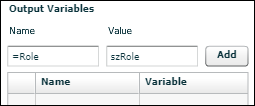
You can reorder the variables by clicking and dragging an item to the location indicated by the black line.
Agent Exit Code
Applies to voice calls when the selected treatment has Enable FLOW Transfer enabled in PBX/CONTACT
Enter a string variable to store the DTMF digits (for example, a customer ID) entered by the user.
ID of the last user to service the call/Username of the last user to service the call
Enter an integer variable to store the user ID and/or a string variable to store the user name of the last user who spoke to the caller before the call returned to the script. This variable is populated if either the Success or Agent Transfer exit routes are used.
Note: see the description of the Get Last Interaction action cell for a description of how a FLOW script is constructed to route an incoming message to the agent who last dealt with that particular contact.
If you select ‘Contact Queue’ as your destination type, additional fields are available to allow you to route the incoming communication to a preferred agent.
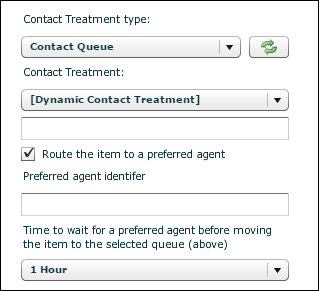
Select the Route the item to a preferred agent field to enable the relevant functionality.
Populate the Preferred agent identifier field to with a string variable that will be used to identify the agent to which the communication should be routed. The system uses the value in this variable to search for a match, first, for the agent’s user ID or extension (if the first three characters of the string are ‘ext’); then for their full name; and then for their username. If the FLOW script is for an OUTBOUND campaign, this field can be used to identify a particular agent to be targeted to handle the communication.
Use the Contact Treatment field to select the queue (or drag a variable into the field provided to identify the queue at run-time) to which the incoming communication should be routed if the agent is unavailable; and use the drop-down list provided to specify how long the system should attempt to deliver the message to the agent before routing it to the queue instead. (Options range from one minute to 14 days.)
See Routing an interaction to the same agent for an example.
For voice calls that are routed in this way:
Once the preferred agent has been identified, while the system is attempting to connect them to that agent, the caller will not hear any of the repeating information messages played to callers in the queue to which the call was originally routed. (They will, however, still hear any hold prompts and music configured for the queue.)
If the treatment-level timeout assigned to the original queue is shorter than the timeout set in the Route to Contact action cell, the treatment-level timeout set for the original queue is applied to the call.
If the treatment-level timeout assigned to the original queue is longer than the timeout set in the Route to Contact action cell, the call is returned to the original queue once the action cell timeout has been reached. The original queue's treatment-level timeout then applies, and is measured from the point at which the call first started waiting to be connected to the preferred agent.
|
Exit point |
Taken |
|
[Success] |
For a successfully routed communication. Also taken when the communication routes back to the script (see the Agent Exit Code parameter) but there is no 'Agent Transfer' route. |
|
[Failure] |
For a communication that has not been routed despite forwarding rules and extended configuration overflow rules having been attempted. Taken for an OUTBOUND call when the outbound queue’s maximum wait time is reached. |
|
[Agent Transfer] |
When an agent enters the defined DTMF sequence for transferring the call back into the script. See the Agent Exit Code parameter. |
|
[Invalid Details] |
When the Contact Treatment parameter is set to '[Dynamic Content Treatment]' and the system cannot identify the intended user. |